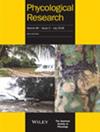柱头Gertia stimatica(Dinophyceae)的半乳糖脂质组成,它是Kareniaceae的一个非典型成员,具有不含周苷的、非触觉植物衍生的质体
IF 1
4区 生物学
Q2 MARINE & FRESHWATER BIOLOGY
引用次数: 4
摘要
柱头Gertia stimatica是Karenia科的一个非典型成员,它有一个含有周苷的质体,而不是像Karenia、Karlodinium和Takayama等典型属中发现的那样,含有(酰氧基)岩藻红素的第三级触植物来源的质体。虽然根据其最初发表的描述,柱头G.stimatica质体的起源尚不确定,但有其他假设表明,它可能起源于获得触觉植物来源的质体之前或之后,但对该物种的描述表明,它确实具有超微结构和遗传特征,将其牢牢地归入Kareniaceae。作为一种光合、含质体的生物,豆状G.stimatica和其他藻类一样,拥有两种半乳糖脂质,一种是半乳糖醛酸甘油,另一种是二半乳糖醛酸甘油(分别为MGDG和DGDG),它们构成了其与质体相关的光合膜的基础。MGDG和DGDG在含有周苷的甲藻中得到了广泛的表征,在那里观察到这些甲藻可以分离成两个簇。一个簇的特征是MGDG和DGDG具有多不饱和C18/C18脂肪酸(sn-1/sn-2区域化学)十八碳五烯酸(18:5(n-3))和十八碳四烯酸(18:4(n-3。相比之下,短Karenia和米基莫托伊Karenia已被观察到富含MGDG和DGDG的物种,如18:5(n-3)/14:0 MGDG和DG,这在含有周氨素的甲藻中是罕见的。我们的目的是对柱头G.stimatica的半乳糖脂质进行表征,将其与含有周苷的甲藻和Kareniaceae的其他成员进行比较,以寻求对其质体进化的见解,如(a)残余的14:0脂肪酸半乳糖脂质。我们的研究结果表明,柱头G.stimatica具有20:5(n-3)/18:5(n-3。讨论了这对柱头G.stimatica质体进化的影响。本文章由计算机程序翻译,如有差异,请以英文原文为准。
Galactolipid composition of Gertia stigmatica (Dinophyceae), an atypical member of the Kareniaceae with a peridinin‐containing, non‐haptophyte‐derived plastid
Gertia stigmatica is an atypical member of the Kareniaceae that has a peridinin‐containing plastid rather than a tertiary, (acyloxy)fucoxanthin‐containing, haptophyte‐derived plastid, as is found in the canonical genera Karenia, Karlodinium, and Takayama. While the origin of G. stigmatica's plastid is uncertain per its original published description, with alternative hypotheses stating that it could have originated before or after the acquisition of a haptophyte‐derived plastid, the description of the species indicates that it does possess ultrastructural and genetic features that firmly place it within the Kareniaceae. As a photosynthetic, plastid‐containing organism, G. stigmatica, like other algae, possesses two galactolipids, mono‐ and digalactosyldiacylglycerol (MGDG and DGDG, respectively), that form the basis of its plastid‐associated photosynthetic membranes. MGDG and DGDG have been extensively characterized in peridinin‐containing dinoflagellates, where it has been observed that these dinoflagellates can be segregated into two clusters. One cluster is characterized by MGDG and DGDG possessing the polyunsaturated C18/C18 fatty acids (sn‐1/sn‐2 regiochemistry) octadecapentaenoic acid (18:5(n‐3)) and octadecatetraenoic acid (18:4(n‐3)), while the second cluster possesses eicosapentaenoic acid (20:5(n‐3)) in the sn‐1 position while retaining a polyunsaturated C18 fatty acid in the sn‐2 position. By contrast, Karenia brevis and Karenia mikimotoi have been observed to be enriched in species of MGDG and DGDG, such as 18:5(n‐3)/14:0 MGDG and DGDG, uncommon to peridinin‐containing dinoflagellates. Our objective was to characterize the galactolipids of G. stigmatica to compare it to both peridinin‐containing dinoflagellates and other members of the Kareniaceae to search for insight, such as (a) remnant 14:0 fatty acid‐containing galactolipid(s), into the evolution of its plastid. Our results show that G. stigmatica possesses 20:5(n‐3)/18:5(n‐3) MGDG and DGDG as the primary galactolipids, with little evidence of those galactolipid species enriched in K. brevis and K. mikimotoi. The implications of this for the evolution of the G. stigmatica plastid are discussed.
求助全文
通过发布文献求助,成功后即可免费获取论文全文。
去求助
来源期刊

Phycological Research
生物-海洋与淡水生物学
CiteScore
3.60
自引率
13.30%
发文量
33
审稿时长
>12 weeks
期刊介绍:
Phycological Research is published by the Japanese Society of Phycology and complements the Japanese Journal of Phycology. The Journal publishes international, basic or applied, peer-reviewed research dealing with all aspects of phycology including ecology, taxonomy and phylogeny, evolution, genetics, molecular biology, biochemistry, cell biology, morphology, physiology, new techniques to facilitate the international exchange of results. All articles are peer-reviewed by at least two researchers expert in the filed of the submitted paper. Phycological Research has been credited by the International Association for Plant Taxonomy for the purpose of registration of new non-vascular plant names (including fossils).
 求助内容:
求助内容: 应助结果提醒方式:
应助结果提醒方式:


